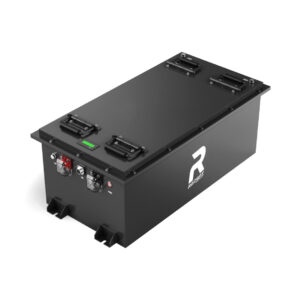How to Maintain RV Lithium-Ion Batteries During Storage?
Proper maintenance of RV lithium-ion batteries during storage involves charging them to 50-60%, storing in a temperature-controlled environment, disconnecting parasitic loads, and performing periodic voltage checks. Lithium-ion batteries require specific care to prevent capacity loss, cell degradation, or safety risks. Following manufacturer guidelines ensures longevity and optimal performance post-storage.
Essential Safety Precautions for RV Batteries
How to Prepare RV Lithium-Ion Batteries for Storage?
Charge batteries to 50-60% state of charge (SOC) using a compatible charger. Disconnect terminals to eliminate parasitic drains from RV systems. Clean terminals with a baking soda solution to prevent corrosion. Store in a dry, climate-controlled space (ideally 32°F–77°F). Use a non-conductive cover to protect terminals from accidental contact.

What Is the Ideal Temperature Range for Storing Lithium-Ion Batteries?
Lithium-ion batteries should be stored at 32°F–77°F (0°C–25°C). Temperatures below 32°F accelerate self-discharge, while heat above 77°F degrades cells. Avoid garages or sheds with extreme temperature swings. Insulate battery compartments or relocate batteries indoors if freezing is anticipated.
| Temperature Range | Effect on Battery | Recommended Action |
|---|---|---|
| <32°F (0°C) | Increased self-discharge rate | Use battery heating pads |
| 32-77°F (0-25°C) | Optimal storage conditions | Maintain 50% SOC |
| >77°F (25°C) | Electrolyte breakdown | Install cooling fans |
Recent studies show lithium batteries stored at 59°F (15°C) with 40% SOC retain 94% capacity after 12 months, compared to 78% retention at 95°F (35°C). Thermal management becomes critical in regions with seasonal extremes. Consider using insulated battery boxes with phase-change materials to buffer temperature fluctuations during storage periods.
RV Battery Water Level Check Frequency
Should You Disconnect RV Lithium Batteries During Storage?
Yes. Disconnect negative terminals to prevent parasitic drains from RV clocks, alarms, or inverters. Use insulated wrenches to avoid short circuits. Leave the battery management system (BMS) active if integrated, as it monitors cell balance and temperature.
How Often Should You Check Stored RV Lithium-Ion Batteries?
Check voltage every 4–6 weeks. Recharge to 50-60% SOC if voltage drops below 12.4V (for 12V systems). Use a multimeter or Bluetooth-enabled BMS for monitoring. Avoid full discharge cycles, as they permanently reduce capacity.
Can You Leave RV Lithium Batteries Connected to a Solar Charger?
Only if using a lithium-specific charge controller. Solar chargers without voltage regulation risk overcharging. Set the charger to “float” mode (13.6V) to maintain 50% SOC. Disconnect panels during long-term storage to prevent erratic charging.
What Are the Risks of Storing Lithium Batteries at Full Charge?
Full charge increases internal cell pressure, accelerating electrolyte breakdown. This reduces cycle life and may cause swelling. Storage above 80% SOC increases calendar aging by 15–25% annually. Always partial-charge before storage.
| Charge Level | Annual Capacity Loss | Swelling Risk |
|---|---|---|
| 100% SOC | 20-25% | High |
| 80% SOC | 15-18% | Moderate |
| 50% SOC | 2-3% | Low |
Laboratory tests reveal lithium cells stored at full charge develop 3x more SEI (solid electrolyte interphase) layer growth compared to those at 50% SOC. This insulating layer reduces ionic conductivity and increases internal resistance. For multi-battery banks, balance individual cell voltages before storage using a quality balancer to prevent accelerated degradation in higher-voltage cells.
How Does Humidity Affect Stored Lithium-Ion Batteries?
High humidity corrodes terminals and promotes dendrite growth, risking internal shorts. Use silica gel packs in storage areas to maintain <60% humidity. Avoid airtight containers—lithium batteries release minimal gas but require airflow.
Expert Views
“Lithium-ion batteries thrive at partial charge during storage. We recommend a 50% SOC and monthly voltage checks. Never store them fully depleted—recovery is often impossible. At Redway, we’ve seen batteries last 10+ years with disciplined storage protocols.” — Redway Power Systems Engineer
Conclusion
Maintaining RV lithium-ion batteries during storage requires balancing charge levels, temperature control, and periodic monitoring. By disconnecting loads, avoiding extremes, and adhering to 50% SOC, users maximize lifespan and ensure reliable power post-storage. Always prioritize manufacturer guidelines for model-specific care.
FAQs
- Can lithium RV batteries freeze?
- While lithium-ion cells won’t freeze until -40°F, sub-32°F storage increases internal resistance and self-discharge. Avoid repeated freezing cycles.
- Should I remove batteries from my RV in winter?
- Yes, if temperatures drop below 14°F (-10°C). Relocate them to a heated space. Cold storage is acceptable if kept above 32°F and SOC is maintained.
- How long can lithium batteries stay in storage?
- Up to 12 months at 50% SOC with bi-monthly checks. Beyond a year, recharge to 50% every 6 months to counteract self-discharge (2–3% monthly).
